
**The Symmetries of a Square
The goal of this investigation is to
describe all of the symmetries of a square and all of the interactions
between these symmetries. A symmetry of a square
is a rigid motion of the plane which leaves the outline of the square
unchanged. In other words, it is a transformation which results in a
square that is superimposed onto the original square.
(Note that a 90 degree
rotation
about the center point of a square is a symmetry of the square,
but a 45 degree
rotation about the center point of a square is not a symmetry
of the square.)
Introduction
You will need to make a
square of
paper the size of the square silhouetted on this sheet of paper
for your investigation. Label the corners of the
square exactly as they are labeled on the silhouette (With W, X, Y,
and Z). The back side of the square should also be labeled so
that, for example, the 'Z' is directly under the 'Z' on the front side
of the cut-out square.
The HOME position of the cut-out square
is a position on top of the square below, with labeled corners touching
labeled corners.
When you are using the cut-out and its
silhouette, it is important to describe and/or act out all rotations
and reflections based on the position of the silhouette. The descriptive
points and lines on the diagram below will always be your frame of reference.

Part
1 - DESCRIBING THE SYMMETRIES
1. Use words to describe
the 8 symmetries of the square. These symmetries are written in
mathematical shorthand below.
R0
R90
R180
R270
H
V
D
D'
2. The rotation R90 can be thought of as a function from {W,X,Y,Z}
to {W,X,Y,Z} and described by an input-output table. The first
column of the table is interpreted as follows: Beginning with
the cutout in home position, the function R90 sends vertex W of the cutout to position X of
the silhouette. Fill in the three missing outputs, and create
similar input-output tables for the other seven symmetries.

Part
2 - Describing interactions between
the symmetries of the square.
1. We use composition of functions
to define an operation on the set of the 8 symmetries of the square.
NOTATION: Juxtaposition of
two of the symbols for symmetries implies composition. We apply
the functions from right to left: so the notation DR90 means first
rotate the cut-out square 90 degrees clockwise, and then reflect the
square about the main diagonal of the silhouette.
Complete the input-output table for DR90 .
 Fill in
the blank, DR90 =___________________
Fill in
the blank, DR90 =___________________
by comparing this input-output table to the
input-output tables that you created on the second page
Repeat this exercise for R90D.
 Fill in the blank: R90D = _____________
Fill in the blank: R90D = _____________
2. Determine the results of all
of the possible compositions of the symmetries of the square.
The table that you create is called the Cayley table of a mathematical
system called the group of symmetries of the square. (The term
'group' is used here because we have a set of objects - the symmetries
- and a nice binary operation - composition of functions - on
which to operate.) What you are doing is something like creating
a multiplication table.
The Cayley Table for the
Group of symmetries of a square.
|
Composition |
R0 |
R90 |
R180 |
R270 |
H |
V |
D |
D' |
R0 |
||||||||
R90 |
||||||||
R180 |
||||||||
R270 |
||||||||
H |
||||||||
V |
||||||||
D |
||||||||
D' |
Groups are algebraic structures which satisfy four properties.
For example, given any two elements in a group, when we compose them,
we obtain some other element of the group, such as in the Cayley table above.
This property is called closure.
Yet, groups do not have to be commutative.
The real numbers are commutative. For the real numbers,
commutativity is a property
of states that when I take two numbers, a and b,
then
a + b = b + a (reals are commutative under +) and
ab=ba (reals are commutative under multiplication)
3. Is the dihedral group commutative? In other words, can you find two symmetries of the square, A and B, in the Cayley table, so that AB is not BA? If so, then the group is not commutative and you should write down A, B, AB and BA.
**Adapted by Dr. Sarah from excerpts taken from
Math 343: Introduction to Algebraic Structures
http://www.humboldt.edu/~dro1/new/elem/ Symmetries%20of%20SQ.doc